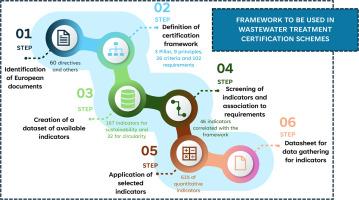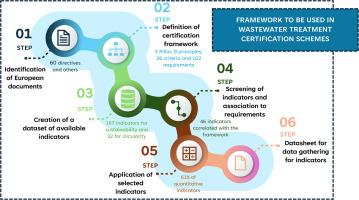Methodological guide and roadmap to assess the compliance of wastewater treatment plants with sustainability and circularity criteria
IF 12.4
1区 环境科学与生态学
Q1 ENGINEERING, ENVIRONMENTAL
引用次数: 0
Abstract
Environmental certification has come up as a voluntary action to demonstrate a minimum quality level when it comes to the introduction of ecological-friendly principles in decision-making. However, most of the work done so far has focused on the food and agroforestry sectors and on the production and processing stages of the value chain rather than end-of life strategies. The present study aims to provide a roadmap that facilitates the evaluation of the performance wastewater facilities from sustainable and circularity perspectives. A six-step framework has been proposed with the objective of serving as the basis for a future certification system for this sector. First, mandatory requirements were collected from European legislative documents to identify the targets to be met. Subsequently, the collected data have been classified into five levels ranging from the definition of pillars, principles, criteria, requirements to the compliance of indicators. The selection of indicators was carried out taking into account the existing literature to gather both sustainability (167) and circularity (32) indicators, which were then associated with the defined requirements. The final step is to consider the testing or validation of the methodology to case studies, in this case, the design and operation of two large-scale wastewater treatment plants. The results indicated that most of the indicators are qualitative and about 61 % of the quantitative requirements of the framework could be calculated with routine plant information. For those indicators for which estimation was not possible due to lack of data, an easily manageable, fact sheet-type template was created so that companies were aware of data required to address the framework. Moreover, the application of this assessment framework to wastewater treatment plants identified some gaps to consider: (1) thresholds could not be defined for many of the indicators, (2) there is a lack of guidelines for data collection, (3) legislation needs improvement regarding circularity metrics in this sector and (4) the requirements should be strengthened to account for the specific characteristics of facilities operating at different scales and using various technologies.


评估污水处理厂是否符合可持续发展和循环标准的方法指南和路线图
环境认证是在决策过程中引入生态友好原则时,为了证明最低质量水平而采取的自愿行动。然而,迄今为止所做的大部分工作都集中在粮食和农林业部门以及价值链的生产和加工阶段,而不是生命终结战略。本研究旨在提供一个路线图,以促进从可持续和循环的角度评价污水处理设施的性能。已经提出了一个六步骤框架,其目标是作为该部门未来认证制度的基础。首先,从欧洲立法文件中收集强制性要求,以确定要达到的目标。随后,收集到的数据被分为五个层次,从支柱的定义、原则、标准、要求到指标的遵守情况。指标的选择考虑了现有文献,以收集可持续性(167)和循环性(32)指标,然后将其与定义的要求联系起来。最后一步是考虑对案例研究方法的测试或验证,在这种情况下,是两个大型污水处理厂的设计和运行。结果表明,大多数指标是定性的,约61%的框架定量要求可以用常规植物信息计算。对于那些由于缺乏数据而无法估计的指标,创建了一个易于管理的情况介绍型模板,以便公司了解处理该框架所需的数据。此外,将这一评估框架应用于污水处理厂,发现了一些需要考虑的差距:(1)许多指标的阈值无法定义,(2)缺乏数据收集的指导方针,(3)该部门的循环度量需要改进立法,以及(4)应加强要求,以考虑不同规模和使用不同技术的设施的具体特点。
本文章由计算机程序翻译,如有差异,请以英文原文为准。
求助全文
约1分钟内获得全文
求助全文
来源期刊

Water Research
环境科学-工程:环境
CiteScore
20.80
自引率
9.40%
发文量
1307
审稿时长
38 days
期刊介绍:
Water Research, along with its open access companion journal Water Research X, serves as a platform for publishing original research papers covering various aspects of the science and technology related to the anthropogenic water cycle, water quality, and its management worldwide. The audience targeted by the journal comprises biologists, chemical engineers, chemists, civil engineers, environmental engineers, limnologists, and microbiologists. The scope of the journal include:
•Treatment processes for water and wastewaters (municipal, agricultural, industrial, and on-site treatment), including resource recovery and residuals management;
•Urban hydrology including sewer systems, stormwater management, and green infrastructure;
•Drinking water treatment and distribution;
•Potable and non-potable water reuse;
•Sanitation, public health, and risk assessment;
•Anaerobic digestion, solid and hazardous waste management, including source characterization and the effects and control of leachates and gaseous emissions;
•Contaminants (chemical, microbial, anthropogenic particles such as nanoparticles or microplastics) and related water quality sensing, monitoring, fate, and assessment;
•Anthropogenic impacts on inland, tidal, coastal and urban waters, focusing on surface and ground waters, and point and non-point sources of pollution;
•Environmental restoration, linked to surface water, groundwater and groundwater remediation;
•Analysis of the interfaces between sediments and water, and between water and atmosphere, focusing specifically on anthropogenic impacts;
•Mathematical modelling, systems analysis, machine learning, and beneficial use of big data related to the anthropogenic water cycle;
•Socio-economic, policy, and regulations studies.
 求助内容:
求助内容: 应助结果提醒方式:
应助结果提醒方式:


